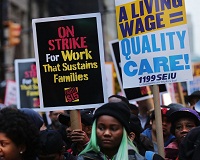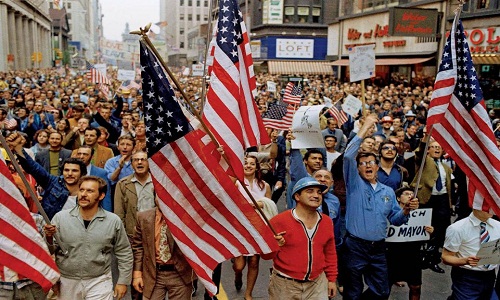"US President Trump’s ‘Make US great again’ has had significant impact on the average hourly wages of garment workers, with their wages getting a spiked 2.9 per cent from the same period last year. Owing to this, unemployment rate dropped to an 18-year low at about 4.1 per cent. Mark Zandi, Chief Economist, Moody’s Analytics, says the job market is very tight and getting tighter. Businesses are struggling to hire or hang onto people so they have no choice but to raise wages. These are people who are very skilled. It’s very difficult to hold onto those workers. The industry also has a high percentage of foreign born workers. "

US President Trump’s ‘Make US great again’ has had significant impact on the average hourly wages of garment workers, with their wages getting a spiked 2.9 per cent from the same period last year. Owing to this, unemployment rate dropped to an 18-year low at about 4.1 per cent. Mark Zandi, Chief Economist, Moody’s Analytics, says the job market is very tight and getting tighter. Businesses are struggling to hire or hang onto people so they have no choice but to raise wages. These are people who are very skilled. It’s very difficult to hold onto those workers. The industry also has a high percentage of foreign born workers. The biggest reason behind this is the immigration restriction imposed by the government, which is forcing manufacturers to pay their remaining workers even more. This is only the beginning. It’s going to get a lot worse.

Senator Tom Cotton, along with Senator David Perdue (R-GA), introduced a legislation in 2017 that would further raise Americans’ wages by reducing the current mass legal immigration levels, where more than one million mostly low-skilled legal immigrants enter the US every year, putting downward pressure on working and middle-class Americans’ wages and job opportunities. At the same time, the Act would shift the current legal immigration system from one that prioritises high-skilled, English-proficient immigrants over those with low-education rates and minor skills.
The scenario till now
According to the Bureau of Labor Statistics, over the past two decades, fashion manufacturing jobs in the US have declined by more than 80 per cent, dropping from about 900,000 jobs in 1990 to just 150,000 jobs in 2011. Just two years after the federal government enacted the North American Free Trade Agreement (NAFTA), companies laid off 706 American workers from fashion manufacturing jobs in the US, with 67,511 workers initially filing for unemployment. Between 1996 and 2011, companies laid off an average of 323 American workers every year in the fashion manufacturing industry. In that same period, American workers in textile mills suffered an average of 200 layoffs per year. In 1996, some 1,040 American workers in the clothing, textile, and leather manufacturing industry were fired from their jobs.
Every year the US admits more than 1.5 million foreign nationals, with the vast majority deriving from family-based chain migration, whereby newly naturalised citizens can bring an unlimited number of foreign relatives to the US. In 2016, the legal and illegal immigrant population reached a record high of 44 million. By 2023, the Center for Immigration Studies estimates that the legal and illegal immigrant population of the US will make up nearly 15 per cent of the entire US population.
Immigrants and low wages
For blue-collar American workers, mass immigration has not only kept wages down, but in many cases, decreased wages. Meanwhile, the US continues importing more foreign nationals against whom working-class Americans are forced to compete. In 2016, the US brought in about 1.8 million mostly low-skilled immigrants.
For white-collar American workers, mass immigration has become a tool for the big business lobby, cheap labour industry, and Silicon Valley elites to replace US citizens with cheaper foreign workers. For example, 71 per cent of tech workers in coveted high-paying, white-collar Silicon Valley jobs are foreign-born, while the tech industry in the San Francisco, Oakland, and Hayward area is made up of 50 per cent foreign-born tech workers. The growing foreign-born population dominating the workforce in Silicon Valley comes as nearly 500,000 Americans graduate in the STEM fields every year. Overall, four million young Americans enter the workforce every year, but their job opportunities are further reduced as there are roughly two new foreign workers for every four American workers who enter the workforce.












